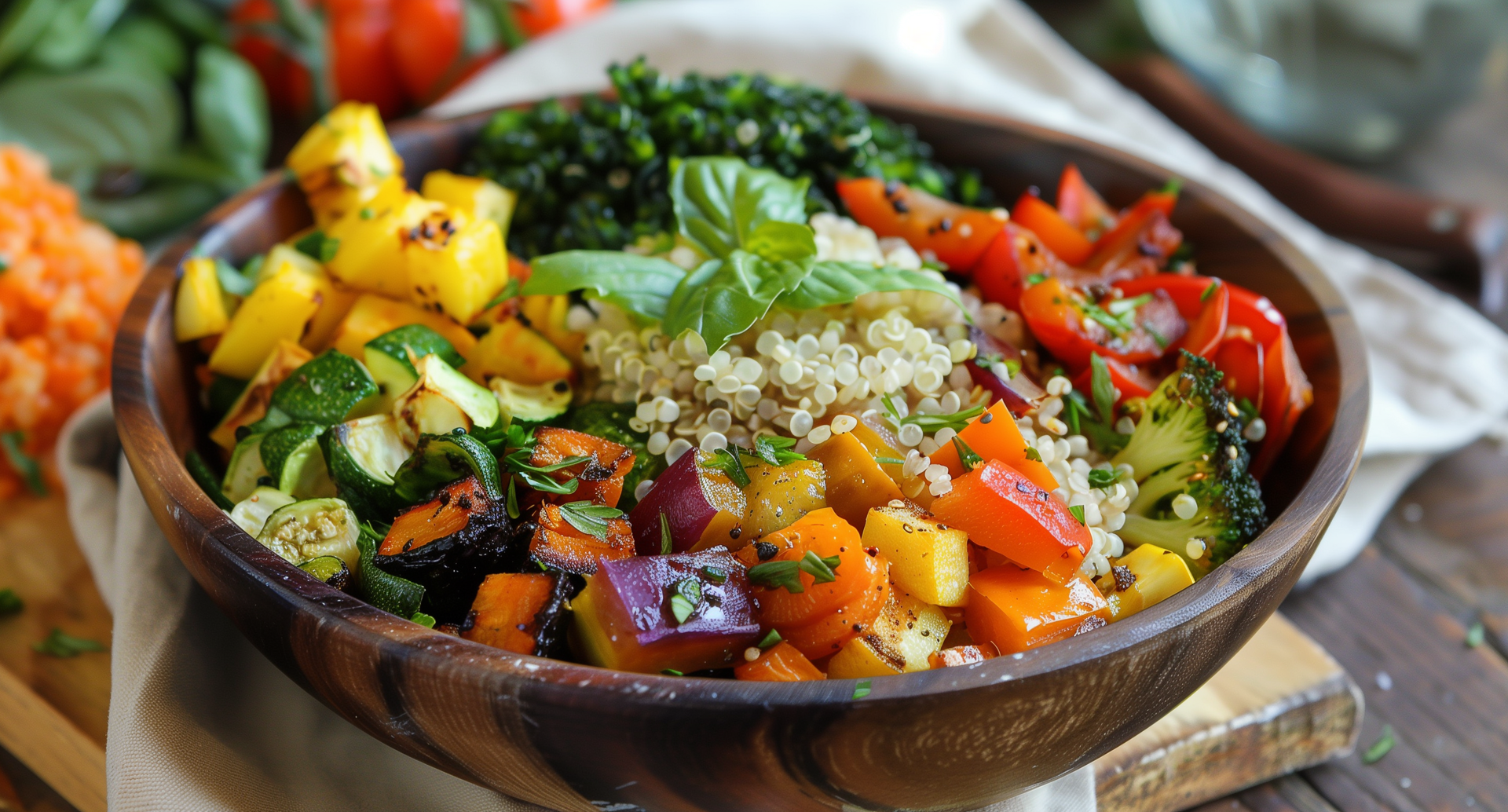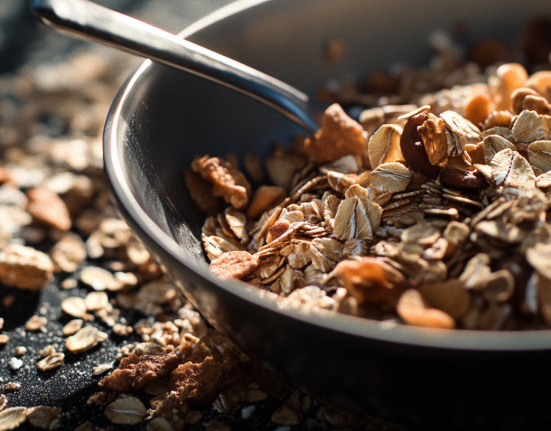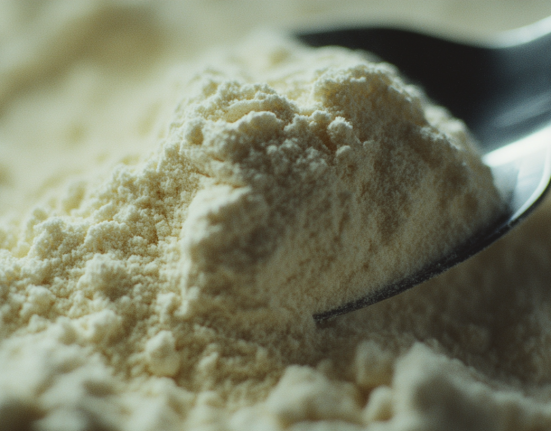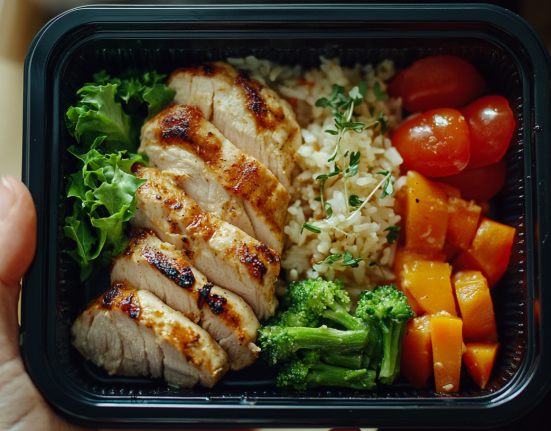Quinoa, often hailed as a “superfood,” is a small but mighty grain that has taken the health food scene by storm. Despite its recent surge in popularity, quinoa is actually an ancient grain that has been cultivated in the Andean region of South America for thousands of years. It was a staple food for the Incas, who called it the “mother of all grains,” and it was revered for its nutritional benefits.
One of the most impressive aspects of quinoa is its nutritional profile. It is one of the few plant foods considered a complete protein, meaning it contains all nine essential amino acids that our bodies cannot produce on their own. This makes it an excellent dietary choice for vegetarians and vegans. Additionally, quinoa is rich in fiber, magnesium, B vitamins, iron, potassium, calcium, phosphorus, vitamin E, and various beneficial antioxidants.
Quinoa comes in various colors, including white, red, and black, each offering slightly different textures and subtle flavor variations. White quinoa, also known as ivory quinoa, is the most common and has the lightest texture and quickest cooking time, making it ideal for those new to cooking this grain. Red quinoa holds its shape better than white quinoa, making it suitable for cold salads where a firmer texture is needed. Black quinoa has an earthier and sweeter taste and is slightly crunchier.
Not only is quinoa gluten-free, but it’s also a fantastic wheat-free alternative, making it a valuable ingredient for those with gluten sensitivities or celiac disease. Its versatility in the kitchen is another reason for its popularity; it can be used in a range of recipes from breakfast porridges to salads, side dishes, and as a base for veggie bowls.
Incorporating quinoa into meals is incredibly easy. It can be prepared simply with water or vegetable broth and makes an excellent base for a variety of toppings and seasonings — a true testament to its adaptability and appeal as a modern-day superfood.
How to Cook Perfect Quinoa for Bowls
Cooking quinoa perfectly is essential to creating delicious and satisfying quinoa bowls. When cooked right, quinoa should be fluffy and light, with a slightly nutty flavor, not mushy or clumpy. Here’s a step-by-step guide to ensuring your quinoa turns out perfectly every time.
-
Rinse the Quinoa
Quinoa naturally has a bitter-tasting coating called saponin. To remove this bitterness, it’s crucial to rinse the quinoa thoroughly under cold water before cooking. Use a fine mesh strainer to rinse and drain the quinoa well.
-
Use the Right Water-to-Quinoa Ratio
The key to perfectly cooked quinoa is using the correct amount of water. A general rule of thumb is to use two cups of water for every one cup of quinoa. This ratio ensures that the quinoa is neither too dry nor overly soggy.
-
Add Flavor
Before cooking, consider adding a pinch of salt or cooking your quinoa in vegetable or chicken broth instead of water. This simple change can significantly enhance the flavor of the quinoa, making it a tastier addition to your bowl.
-
Cook It
To cook quinoa, combine the rinsed quinoa and liquid in a saucepan and bring it to a boil. Once it’s boiling, reduce the heat to low and cover the pan. Let it simmer for about 15 minutes, or until all the liquid is absorbed and the quinoa’s germ (the tiny spirals) separates. Avoid stirring quinoa while it’s cooking as this can break the grains and make them mushy.
-
Let It Sit
After the quinoa has absorbed all the liquid, remove it from the heat and let it sit, covered, for about 5 minutes. This allows the quinoa to steam and become fluffier. After it has rested, fluff it gently with a fork.
-
Season to Taste
Before adding quinoa to your bowl, give it a taste and adjust the seasoning if necessary. A little extra salt, a squeeze of lemon juice, or a drizzle of olive oil can boost the flavor, making it a perfect base for your vegetable toppings.
By following these steps, you’ll get light, fluffy quinoa that’s ideal for incorporating into any type of bowl. Whether you’re adding roasted vegetables, fresh herbs, or a protein, perfectly cooked quinoa can elevate your dish and add a nutritional punch.
Choosing the Right Vegetables for Roasting
Creating a delectable quinoa and roasted vegetable bowl starts with selecting the right vegetables. Roasting enhances the natural sweetness and flavors of vegetables, making it a crucial step in assembling your bowl. Here’s how to choose the best vegetables for roasting that will complement your quinoa base.
-
Seasonal Selection
Opt for seasonal vegetables as they are at their peak in flavor and nutritional content. Seasonal choices ensure you’re getting the freshest produce possible, which translates into tastier, more flavorful dishes. For example, squash and Brussels sprouts are great in fall and winter, while asparagus and bell peppers shine in the spring and summer.
-
Variety of Colors and Textures
Choose a mix of colors and textures to make your bowl visually appealing and nutritionally balanced. Include a combination of root vegetables like carrots or sweet potatoes for sweetness, cruciferous vegetables like cauliflower or broccoli for a bit of crunch, and softer vegetables like zucchini or tomatoes for moisture and a different texture.
-
Size Matters
Cut your vegetables into uniform pieces to ensure even cooking. Larger chunks might require a longer roasting time compared to smaller pieces. Consider the density of the vegetables as well; denser vegetables like potatoes and carrots take longer to cook than softer ones like onions or bell peppers.
-
Oil and Seasoning
Before roasting, toss your vegetables in a light coat of high-heat-tolerant oil, such as avocado oil or extra virgin olive oil. This helps them roast evenly and enhances their natural flavors. Season your vegetables with salt, pepper, and other spices like rosemary, thyme, or smoked paprika for added depth.
-
Roasting Time and Temperature
Most vegetables roast well at a temperature between 400°F (204°C) and 425°F (218°C). The high heat helps to caramelize the sugars in the vegetables, bringing out their natural sweetness and flavor. Depending on the type and cut of your vegetables, roasting times can vary. Generally, it takes about 20-30 minutes for most vegetables to roast, but always check for tenderness as your cooking time may vary.
-
Final Flavor Boost
After roasting, consider tossing your vegetables in a touch of acid like balsamic vinegar or lemon juice. This can help to cut through the natural sweetness of the roasted vegetables and add a refreshing brightness to the dish.
By selecting the right vegetables and preparing them properly, you not only maximize their flavors and textures but also create a colorful and nutritious foundation for your quinoa bowl. This combination can be a delightful way to enjoy a hearty, healthy meal that is as pleasing to the eye as it is to the palate.
Step-by-Step Guide to Roasting Vegetables
Roasting is a simple and effective way to bring out the rich flavors and textures of vegetables. The high heat of the oven caramelizes the natural sugars in vegetables, resulting in deliciously sweet and savory bites. Here’s a step-by-step guide to roasting vegetables that will complement your quinoa bowl perfectly.
-
Preheat Your Oven
Start by preheating your oven to 425°F (218°C). This high temperature is ideal for achieving a good caramelization on the vegetables while keeping them tender and juicy inside.
-
Prepare the Vegetables
Wash and dry your vegetables thoroughly. Peeling is optional and depends on the type of vegetable and your preference. Cut the vegetables into uniform sizes to ensure even cooking. For denser vegetables like carrots and potatoes, consider cutting them into smaller pieces compared to softer vegetables like zucchini and bell peppers.
-
Toss with Oil and Seasonings
Place the prepared vegetables in a large bowl. Drizzle with a suitable amount of olive oil or another high-heat oil such as avocado oil. Add salt, pepper, and any other desired seasonings like garlic powder, rosemary, or thyme. Toss everything together until the vegetables are evenly coated.
-
Arrange on a Baking Sheet
Spread the vegetables out in a single layer on a baking sheet lined with parchment paper. Avoid overcrowding the pan, as this can cause the vegetables to steam rather than roast, preventing them from getting that delicious crispy edge.
-
Roast the Vegetables
Place the baking sheet in the preheated oven and roast the vegetables. The cooking time will vary depending on the type and size of the vegetables:
- Dense vegetables like sweet potatoes and squash might take 25-30 minutes.
- Medium-density vegetables like bell peppers and broccoli might take 20-25 minutes.
- Soft vegetables like tomatoes and mushrooms might take 15-20 minutes.
Check the vegetables halfway through the cooking time and stir or flip them to ensure even roasting on all sides.
-
Check for Doneness
Vegetables are done when they are tender enough to pierce with a fork and have golden brown edges. The high heat will have deepened their colors and enhanced their natural flavors.
-
Finishing Touch
Once out of the oven, you can add a final flavor boost by sprinkling your roasted vegetables with fresh herbs, a squeeze of lemon juice, or a dash of balsamic vinegar for added zest.
This step-by-step guide will help you achieve perfectly roasted vegetables every time, making them a delightful and nutritious addition to your quinoa bowl. Enjoy the depth of flavor and variety of textures that roasting brings to your dish!
Assembling Your Quinoa and Roasted Vegetable Bowl
After preparing your fluffy quinoa and savory roasted vegetables, it’s time to assemble your bowl. This section provides guidance on how to bring all the elements together to create a balanced, nutritious, and visually appealing meal.
-
Choose Your Bowl
Start with a deep bowl or a wide plate that gives you ample space to arrange your ingredients. Choosing the right dish can enhance your eating experience by making it easy to mix ingredients as you eat.
-
Layer the Quinoa
Begin by placing a serving of quinoa at the bottom of your bowl. This acts as the base of your dish. You can use about half a cup to one cup of quinoa per bowl, depending on your appetite and dietary needs.
-
Add the Roasted Vegetables
Arrange your roasted vegetables on top of the quinoa. You can place them in sections for a more organized look, or mix them for a more casual presentation. Be generous with the vegetables; they should be the star of the bowl.
-
Include a Protein (Optional)
If you like, add a protein source to make your bowl more filling. This could be grilled chicken, baked tofu, tempeh, or a boiled egg. Adding protein is especially important if you’re using this bowl as a main meal.
-
Garnish for Flavor and Texture
Garnishes can transform your bowl from good to great. Consider adding a handful of fresh herbs like parsley, cilantro, or basil for freshness. Sprinkle on some seeds like pumpkin or sunflower for crunch, or add nuts like chopped almonds or walnuts for a bit of richness.
-
Dress It Up
Drizzle your bowl with a dressing to tie all the flavors together. A simple lemon-tahini dressing, a balsamic vinaigrette, or even a creamy avocado dressing can enhance the overall taste of your bowl. Alternatively, a squeeze of fresh lemon or lime juice can brighten up the flavors without extra calories.
-
Serve Immediately
Serve your quinoa and roasted vegetable bowl immediately after assembling to enjoy the mix of flavors and textures at their best. If preparing for later, keep the dressing separate and add just before serving to maintain the freshness and crunch of the ingredients.
By following these steps, you’ll create a satisfying quinoa and roasted vegetable bowl that is not only healthy but also a feast for the eyes and the palate. Enjoy your colorful and nutritious creation that’s perfect for a hearty lunch or a light dinner.
Quinoa and Roasted Vegetable Bowl FAQs
Quinoa and roasted vegetable bowls are a popular meal choice for those seeking a nutritious and satisfying option. Here are some frequently asked questions that might arise when preparing and enjoying this dish.
-
Can I prepare quinoa and vegetables ahead of time?
Yes, both quinoa and roasted vegetables can be prepared in advance. Store them separately in airtight containers in the refrigerator for up to 5 days. When ready to eat, reheat the quinoa and vegetables separately in the microwave or on the stovetop, and assemble your bowl.
-
What are some good dressings for a quinoa and vegetable bowl?
Dressings can vary depending on your taste preferences. Some popular options include:
- Lemon-tahini dressing for a creamy, tangy flavor.
- Balsamic vinaigrette for a sweet and tangy zest.
- Avocado dressing for a creamy, rich texture.
- Simple olive oil and red wine vinegar with a pinch of salt and pepper for a classic touch.
-
How can I make my bowl more filling?
To make your quinoa and vegetable bowl more filling, consider adding a source of protein such as grilled chicken, fish, tofu, tempeh, or beans. Adding a healthy fat like avocado or a handful of nuts can also increase satiety.
-
Is this bowl suitable for meal prep?
Absolutely! This bowl is excellent for meal prep. Prepare a large batch of quinoa and roast a variety of vegetables at the start of the week. Divide into portions and store in the refrigerator. You can mix and match dressings and proteins each day for variety.
-
Can I freeze the cooked quinoa and roasted vegetables?
Cooked quinoa can be frozen for up to a month, making it a great make-ahead option. However, roasted vegetables are best enjoyed fresh; they can become soggy when thawed from frozen. If you need to freeze them, reheat in the oven to restore some of their crispness.
-
What vegetables are best for roasting for this bowl?
Choose vegetables that will maintain a nice texture and flavor when roasted. Good options include bell peppers, zucchini, carrots, onions, broccoli, cauliflower, sweet potatoes, and Brussels sprouts. You can also experiment with seasonal vegetables for variety.
-
How do I keep the vegetables from getting soggy in the bowl?
To prevent soggy vegetables, ensure they are well-roasted to begin with, as this helps to remove excess moisture. Also, allow them to cool slightly before adding them to the bowl if you are eating immediately. If storing, keep the dressing separate until ready to serve.
By addressing these FAQs, you can enhance your experience and enjoyment of making and eating quinoa and roasted vegetable bowls, ensuring delicious results every time.
The Ultimate Quinoa and Roasted Vegetable Bowl Recipe
This recipe for a quinoa and roasted vegetable bowl is designed to be nutritious, filling, and versatile, providing a perfect balance of flavors and textures. Here’s how to put together the ultimate bowl.
Ingredients:
-
Quinoa:
-
- 1 cup quinoa (any color)
- 2 cups water or vegetable broth
- Pinch of salt
-
Roasted Vegetables:
-
- 1 medium sweet potato, peeled and cubed
- 1 red bell pepper, seeded and chopped
- 1 zucchini, chopped
- 1 yellow squash, chopped
- 1 red onion, sliced
- 2 cups broccoli florets
- 2 tablespoons olive oil
- Salt and pepper to taste
- 1 teaspoon dried herbs (like thyme or rosemary)
-
Protein (optional):
-
- 1 cup chickpeas, rinsed and drained
- 1 block tofu, pressed and cubed
-
Dressing:
-
- 3 tablespoons olive oil
- 1 tablespoon balsamic vinegar
- 1 tablespoon maple syrup
- 1 garlic clove, minced
- Salt and pepper to taste
-
Garnish:
-
- Fresh parsley, chopped
- Lemon wedges
- ¼ cup roasted sunflower seeds
Instructions:
-
Prepare the Quinoa:
-
- Rinse the quinoa under cold water until the water runs clear.
- In a medium saucepan, combine the quinoa, water or broth, and a pinch of salt. Bring to a boil over high heat.
- Reduce heat to low, cover, and simmer for 15 minutes, or until all the water is absorbed.
- Remove from heat and let it sit, covered, for 5 minutes. Fluff with a fork and set aside.
-
Roast the Vegetables:
-
- Preheat your oven to 425°F (218°C).
- Toss the sweet potato, bell pepper, zucchini, yellow squash, red onion, and broccoli with olive oil, salt, pepper, and dried herbs.
- Spread the vegetables in a single layer on a baking sheet. Roast for 25-30 minutes, stirring halfway through, until vegetables are tender and have caramelized edges.
-
Prepare the Protein:
-
- If using chickpeas or tofu, toss them with a little olive oil and a pinch of salt. Spread on a separate baking sheet and roast in the oven for 20 minutes until golden and crispy.
-
Make the Dressing:
-
- In a small bowl, whisk together olive oil, balsamic vinegar, maple syrup, minced garlic, salt, and pepper.
-
Assemble the Bowl:
-
- In serving bowls, layer the fluffy quinoa, roasted vegetables, and protein if using.
- Drizzle with the dressing and toss gently to combine.
- Garnish with chopped parsley, a sprinkle of sunflower seeds, and a squeeze of fresh lemon juice.
-
Serve:
-
- Enjoy your delicious quinoa and roasted vegetable bowl immediately, or store in the refrigerator for a ready-to-go meal.







Leave feedback about this